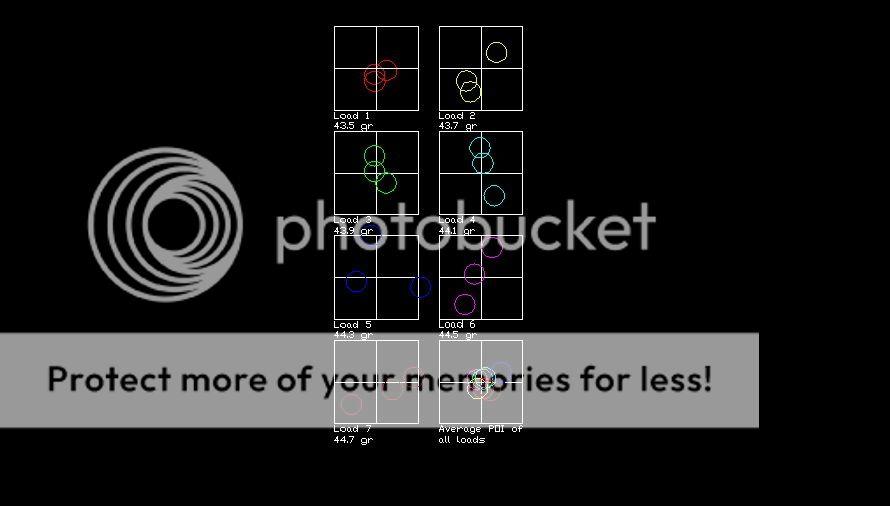Hi Guys,
I followed Dan Newbury's OCW Method to the letter and chose 7 charges to test, but although the visual picture seems to indicate something, using the average POI of each group as suggested, reveals that the average POI's all print within a 0.68" group at 110 yards (if you exclude the 5th group that is 0.4" at 110 yards)
Looking at the targets from left to right the group sizes and average POI for each group reads as follows:
#1 – 43.5 Grains 0.375" group X1.05, Y0.84
#2 – 43.7 Grains 0.794" group X0.92, Y0.84
#3 – 43.9 Grains 0.778" group X1.04, Y1.07
#4 – 44.1 Grains 1.198" group X1.11, Y1.10
#5 – 44.3 Grains 1.701" group X1.48, Y1.23
#6 – 44.5 Grains 1.509" group X0.91, Y1.05
#7 – 44.7 Grains 1.625" group X1.23, Y0.80
I cannot see the average POI following any noticeable trend, however the groups do tend to open up as the loads gets bigger. From the results it also seems that I might benefit from starting a couple of charges lower.
Unfortunately I could not get hold of a chronograph for this test and cannot tell you the velocities achieved in the test.
Cal: .243 Win
Bullet: Hornady 87gr hpbt
Brass: Remington, fired once before and neck sized only for this load.
Powder: Somchem 365 (comparable to IMR4350 or AR2209 or H205)
Primer: PMP Magnum large rifle
Rifle: Steyer Manlicher L with 22" barrel
Average POI for each group was determined by adding all the x values for that group and dividing by 3 and all the y values and dividing by 3 (3 shot groups)
Group sizes were calculated using Point Blank software.
Would anyone care to give me their 2 cents worth on these results?
Thanks
Pieter
I followed Dan Newbury's OCW Method to the letter and chose 7 charges to test, but although the visual picture seems to indicate something, using the average POI of each group as suggested, reveals that the average POI's all print within a 0.68" group at 110 yards (if you exclude the 5th group that is 0.4" at 110 yards)
Looking at the targets from left to right the group sizes and average POI for each group reads as follows:
#1 – 43.5 Grains 0.375" group X1.05, Y0.84
#2 – 43.7 Grains 0.794" group X0.92, Y0.84
#3 – 43.9 Grains 0.778" group X1.04, Y1.07
#4 – 44.1 Grains 1.198" group X1.11, Y1.10
#5 – 44.3 Grains 1.701" group X1.48, Y1.23
#6 – 44.5 Grains 1.509" group X0.91, Y1.05
#7 – 44.7 Grains 1.625" group X1.23, Y0.80
I cannot see the average POI following any noticeable trend, however the groups do tend to open up as the loads gets bigger. From the results it also seems that I might benefit from starting a couple of charges lower.
Unfortunately I could not get hold of a chronograph for this test and cannot tell you the velocities achieved in the test.
Cal: .243 Win
Bullet: Hornady 87gr hpbt
Brass: Remington, fired once before and neck sized only for this load.
Powder: Somchem 365 (comparable to IMR4350 or AR2209 or H205)
Primer: PMP Magnum large rifle
Rifle: Steyer Manlicher L with 22" barrel
Average POI for each group was determined by adding all the x values for that group and dividing by 3 and all the y values and dividing by 3 (3 shot groups)
Group sizes were calculated using Point Blank software.
Would anyone care to give me their 2 cents worth on these results?
Thanks
Pieter

